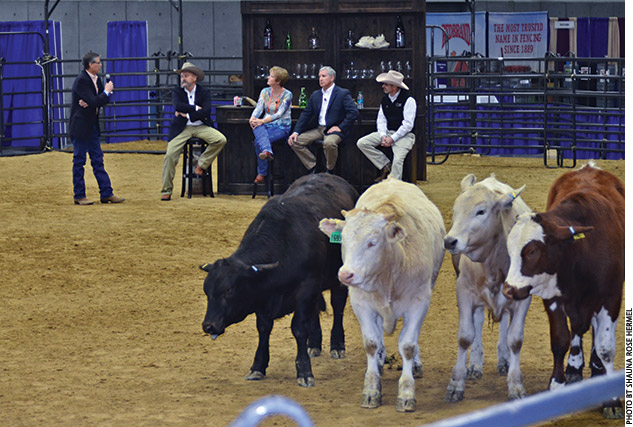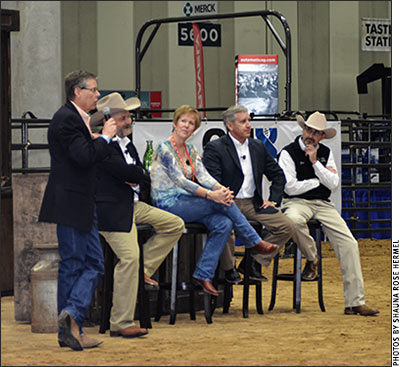
A Whole-herd Makeover — Cowboy Style
Industry leaders discuss what cattlemen can do to improve the nation’s cow herd in an era of herd expansion.
SAN DIEGO, Calif. (Jan. 26, 2016) — Five well-known — and well-respected — individuals in the beef industry shared their opinions and perspectives on the industry’s future during the Cattlemen’s College Hands-on Demonstration late Tuesday afternoon, Jan. 26, at the San Diego Convention Center in San Diego, Calif.
The panel included David Daley, a California rancher and interim dean for the College of Agriculture at California State University, Chico; Patsy Houghton, owner and operator of Kansas-based Heartland Cattle Co.; Tom Brink, founder of Top Dollar Angus Inc. and new CEO of the Red Angus Association of America; and Don Schiefelbein, co-owner of Schiefelbein Farms at Kimball, Minn. Moderator Tom Field with the University of Nebraska facilitated questions and weighed in on the discussion, while Kent Andersen, technical services specialist for sponsor Zoetis, introduced the “barstool discussion” and provided the session wrap-up.

Moderator Tom Field (left) with the University of Nebraskawith the panel: David Daley, a California rancher and interim dean for the College of Agriculture at California State University, Chico; Patsy Houghton, owner and operator of Kansas-based Heartland Cattle Co.; Tom Brink, founder of Top Dollar Angus Inc. and new CEO of the Red Angus Association of America; and Don Schiefelbein, co-owner of Schiefelbein Farms at Kimball, Minn.
The panel covered a cross-section of topics — from expanding the cow herd to how best to use DNA testing, as well as encouraging and assisting young people to get started in the beef business.
Regarding status of the beef industry, one question posed was: Are we (the beef industry) becoming like the sheep industry? Daley responded saying, “I don’t see that; demand is still strong … People like our product. I’m an optimist.”
He noted that for beef to remain profitable it will be important to keep costs in line and continue to promote and expand export markets.
Schiefelbein emphasized the continuing importance for the industry to remain consumer-focused.
“We need to always ask: Were these animals produced with the consumer in mind. If they aren’t, it doesn’t matter how many pounds they gain or their [future] fertility. If we don’t make a product that the consumer wants, nothing happens. We’ve got to keep that in perspective,” he said.
The need for function
In discussing the “right kind” of cattle needed for the future of the industry, the panel agreed that different environmental conditions and resources will dictate what genetics and technology tools producers can utilize. Fertility and growth were identified as important traits, and crossbreeding as an important tool.
Daley expressed that in the West he and many other ranchers have the challenge of running cattle on public lands.
“We may not see the cattle in months,” he said. “It’s really critical in our operation to get them to function on minimal forage; they aren’t going to get a lot of inputs. I stress crossbreeding in our [western] environment. Every place is going to be different."
Brink commented, “Crossbreeding has a lot of value. But there is such a thing as crossbreeding done wrong.” He then referenced the seven light-muscled, straggly crossbred steers of Mexican origin that were on display for the event, saying, “I think we see some of that in front of us today.” Brink added, “Simply crossbreeding [for the sake of crossbreeding] can result in some of this. Producers need to have crossbreeding with a true plan that they stick to over time.”
Of his 15-year experience in the cattle-feeding sector, Brink noted, “When people sell cattle and it takes three or four sentences to describe them, to me, the value goes down. If you can describe them in one sentence [because they are consistent], they have more value.”
DNA can be advantageous
Brink also advocated that producers utilize DNA testing if it fits their operation. In particular, he advised utilizing DNA to test heifer replacement candidates.
“I believe it’s a good use of dollars to do that. Then use the test data not to solely finalize replacement selection, but in conjunction with other factors.”
Brink suggested to producers, “Knock off the lowest-scoring 10%-15% [of heifers]; that’s a tremendous use of the DNA information. Every herd has a tail end; some we can see, but some is genomic. That’s ones of the best, simplest most powerful ways to use that information.”
Regarding the power of genomics, Schiefelbein called the progress made with DNA testing “unbelievable” over the past five years. He added, “A genetic revolution is coming that will greatly increase genetic improvement in a single generation.”
For the future, Houghton expressed a need for more testing that may help identify genetic mutations, especially related to fertility, saying that would be “the most beneficial to the industry.” Over the past 25 years, Houghton’s business has developed and bred more than 100,000 heifers.
She shared that in the last five years a disturbing trend is being seen in their heifer development data — about 20% of heifers are not breeding up. Houghton indicated that it appears to be due to a genetic issue.
“The industry needs to be aware of this trend,” she added. “It’s important to have cows that can put a calf on the ground.”
Houghton also expressed that she would like to see mandatory whole-herd reporting, calling it a “very important concept.”
Herd expansion
When asked about herd expansion, each panelist shared advice.
“I say you want to expand smartly,” Schiefelbein shared. He said he was guilty of trying to expand too fast in the past year. Then the market changed.
“I paid my tuition,” he said. “You have to be smart about it. The break in the market brought common sense back and said slow down expansion. I think we’ll be better for the long haul. … Now our growth will be deliberate and smart.”
Still, he advised taking risks, saying, “Sometimes you need to plow forward … can’t live on running scared. There’s a statement in the wrestling world: ‘It’s better to have wrestled and lost, than to have played basketball.’ You can’t run scared. Got to get out on the mat and see if you can do it.”
Daley noted, “It’s hard to expand unless you have a good plan and a banker who likes you.” He added, “The challenge with expansion is the weather; you aren’t going to control that.”
Longevity is also important to expansion, Daley said, “If I don’t have longevity in my cow herd, I can’t expand. It’s expensive to replace a cow.”
He pondered that there “are a few producers who are smart enough to be counter-cyclical, and concluded, “You gotta have the feed, gotta have the cattle, and gotta have rain.”
Brink emphasized keeping quality of the final beef product in mind when looking at expansion. He advised the use of selection tools, saying, “Selection indexes are a great tool to make multi-trait progress.” He also advised, “Expand with more marbling. That’s where you get a premium on calves. It pays in the marketplace every day.”
Houghton emphasized seeking genetic variation in outcrosses among breeds. Regarding whether or not producers should expand she said, “I think economics answers the question just by itself. … The good ones still bring good money.”
She also emphasized, “We have a lot of commercial producers who want to be seedstock’s little brother, but that’s not their role in the industry. Seedstock producers are genetic creators and commercial producers are genetic multipliers whose role is to take those genetics and produce as much consistent product as possible. Commercial producers need to focus on the role of multiplying proven genetics.”
Editor’s Note: The articles used within this site represent a mixture of copyrights.This article was written by or under contract of the Angus Journal, an Angus Media publication. If you would like to reprint or repost the article, you must first request permission by contacting the editor at 816-383-5270; 3201 Frederick Ave., Saint Joseph, MO 64506. The Angus Journal claims copyright to this website as presented. We welcome educational venues and cattlemen to link to this site as a service to their audience.

